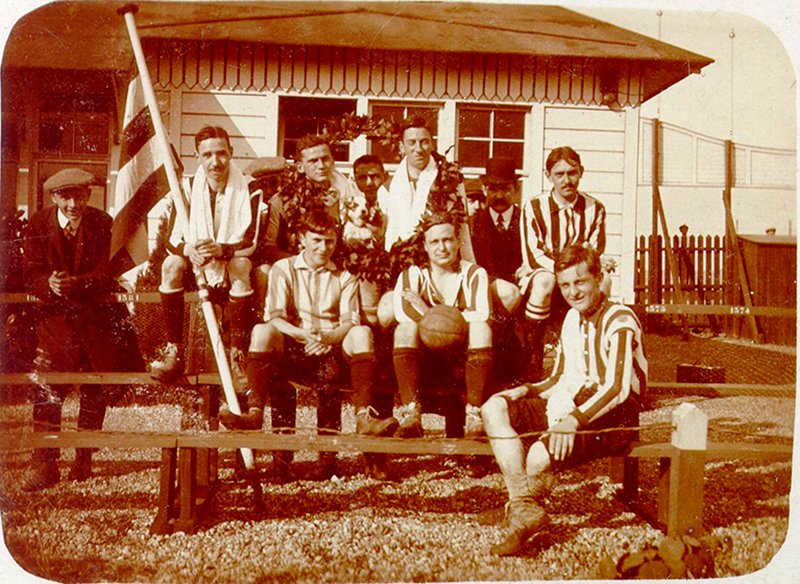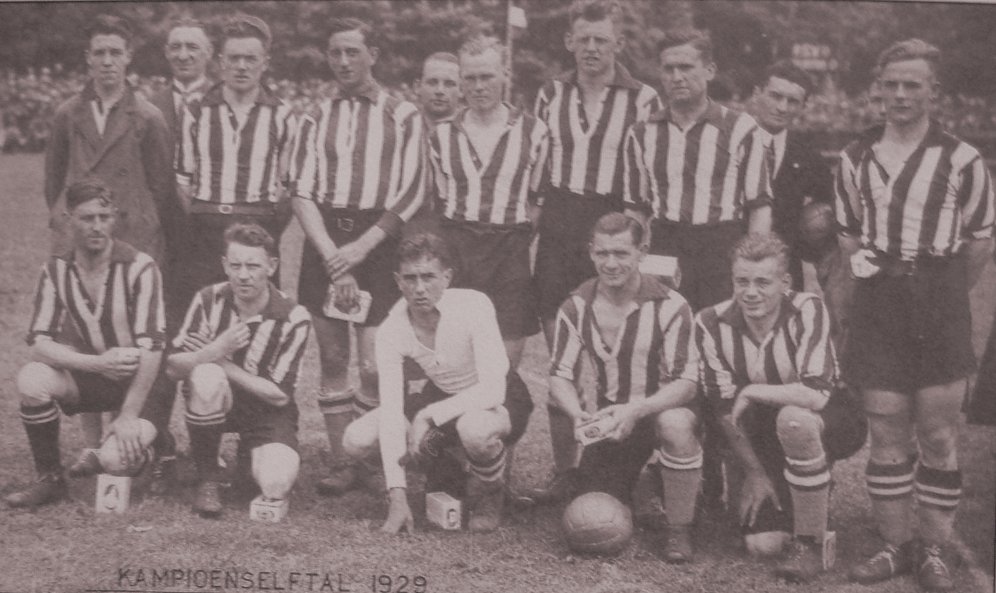The ‘relatives’ of Athletic (and II)
The ‘relatives’ of Athletic (and II)
We go through some of the best stories of the red-and-white t- shirts in Europe and America
In the Old Continent, Sparta Rotterdam, the oldest club in the Netherlands (1888), remains faithful to their traditional red-and-white clothing with black trousers. The idea was imported by several managers who liked the Sunderland outfit and therefore, decided to introduce it in 1899. In addition, on his shield you can see a player controlling the ball with luggage reminiscent of the Athletic Club style, including the red-and-white striped horizontal socks. Like our lions of San Mamés, Sparta had never been relegated until 2002, although they have now got back to the category.

Sparta lineup, Holland Champions
PSV Eindhoven also wears red-and-white colours along with vertical stripes on their t-shirts, the same colours as the other two most competitive teams at the Eredivisie since professionalization of the sport in the 1950s, Ajax and Feyenoord. PSV won the European Cup in 1988 with high quality players such as Ronald Koeman, Soren Lerby and Eric Gerets. 75 years before, in 1913, the club was founded to keep the employees of the Philips Electronics Company entertained (hence the name of Philips Sport Vereniging – Dutch for ‘Philips Sports Club’). At its founding meeting, the Club’s first president, Jan-Willem Hofkes, was surprised by the contrasting colours of his red raspberry lemonade on the table with a white notebook, and the combination gave rise to the t-shirt, with black added to the trousers. Moreover, some people think romantically that the shield of the Braban of the North, the province where the city of Eindhoven is located, was taken into account as well. Therefore, the first PSV kit consisted of a red-and-white t-shirt with vertical stripes, black shorts and red and white socks with horizontal stripes, which has been kept ever since, although in different versions, with some temporary amendments to an entirely red t-shirt.

The PSV champion team in 1929
Red Star, Serbia’s most successful club, was founded in Belgrade in 1945 and has a European Cup and an Intercontinental title to its name (1991), both of which were won by players of the standing of Sinisa Mihajlovic and Dejan Savicevic. At the end of the Second World War, SK Yugoslavija, one of the most popular teams in the former Yugoslavia, which in turn came from another team called SK Velika Srbija (‘Greater Serbia’), was closed down after being considered by the communist authorities of Marshal Tito as ‘collaborator of the enemy’. The Red Star came up from the remains of that team and adopted its red-and-white colours at the request of its first vice-presidents, Zoran Žujović and Slobodan Ćosić. Therefore, the traditional Red Star uniform consists of a red-and-white vertical striped shirt and red or white trousers and socks. Sometimes it has been changed to an entire red or full white uniform. In any case, the Serbian team, whose fierce rivals in the country are FK Partizan, has ,for most of its time worn vertical stripes that are considerably thicker than those of Athletic Club.
The most successful club in the history of Greek football, Olympiacos Piraeus (founded in 1925 with a name inspired by the Ancient Olympics), agrees with our team on two points: their players are wearing red-and-white clothing and have never been relegated to lower categories. The assignment of the sporting colours resulted from the club’s emblem, which depicts a teenage Olympic winner crowned with laurels, with the exclusivity of red and white.The first symbolizing a passion for success while the second symbolizes purity and noble rivalry. The idea of the colours was assigned to Yannis Andrianopoulos, one of five brothers from an acclaimed family in Piraeus, whose father co-founded Olympiacos. The five Andrianopoulos were all strikers and that attacking line soon became legendary in a team that has one of the most controversial rivalries on the planet with neighbours like Panathinaikos, with whom they dispute the ‘derby of the eternal enemies’. The traditional uniform of Olympiacos is a red-and-white vertical striped t-shirt, with red trousers and socks. The t-shirt has undergone different designs throughout its history, for example with thin or wider stripes.
A red-and-white Argentinean with history
On the other side of the Atlantic Ocean, the most famous football club that bears some resemblance to Athletic Club is Estudiantes de la Plata, from the province of Buenos Aires, whose official pet is the lion as well (whose 1968 photo illustrates the header of this report).
Commonly known as ‘pincharratas’, the club’s fans call themselves ‘tetracampeones’ (four-time champions) in reference to the fact that Estudiantes won Copa Libertadores de America four times, three of them consecutively in the late 1960s with Carlos Bilardo and ‘Bruja’ Juan Ramon Veron in the line-up, and subsequently won the Intercontinental Cup in 1968 after defeating Manchester United.
The colours and design of its kit, with vertical bright red-and-white stripes, were established at a meeting of the founding members held in 1906, leaning towards those shown by the teams of the English High School, the school to which most of them belonged (the founder of this institution, Alexander Watson Hutton, is considered the ‘founding father’ of Argentinean football). However, those colours were already used by former students of the school, the Alumni Athletic Club, so the uniform was rejected by the Argentinean Football Association, and for this reason it was redesigned with wider vertical stripes. When the Alumni disappeared in 1913, Estudiantes included five red and four white stripes on the t-shirt, as had originally been established when the club was founded. The trousers and socks of traditional official uniform are black.
